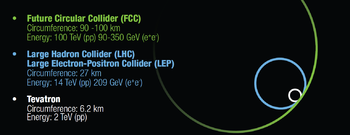
The Future Circular Collider (FCC) is a proposed particle accelerator with an energy significantly above that of previous circular colliders, such as the Super Proton Synchrotron, the Tevatron, and the Large Hadron Collider (LHC).[1][2] The FCC project is considering three scenarios for collision types: FCC-hh, for hadron-hadron collisions, including proton-proton and heavy ion collisions, FCC-ee, for electron-positron collisions, and FCC-eh, for electron-hadron collisions.[3]
In FCC-hh, each beam would have a total energy of 560 MJ. With a centre-of-mass collision energy of 100 TeV (vs 14 TeV at LHC) the total energy value increases to 16.7 GJ. These total energy values exceed the present LHC by nearly a factor of 30.[4]
CERN hosted an FCC study exploring the feasibility of different particle collider scenarios with the aim of significantly increasing the energy and luminosity compared to existing colliders. It aims to complement existing technical designs for proposed linear electron/positron colliders such as the International Linear Collider and the Compact Linear Collider.
The study explores the potential of hadron and lepton circular colliders, performing an analysis of infrastructure and operation concepts and considering the technology research and development programmes that are required to build and operate a future circular collider. A conceptual design report was published in early 2019,[5] in time for a scheduled update of the European Strategy for Particle Physics.
- ^ Benedikt, M.; Zimmermann, F. (28 March 2014). "The Future Circular Collider Study". CERN Courier. Retrieved 4 July 2018.
- ^ Benedikt, M.; Zimmermann, F. (Spring 2015). "Future Circular Collider (FCC) Study". FIP Newsletter. Retrieved 4 July 2018.
- ^ "The Future Circular Collider". 13 June 2023.
- ^ https://cds.cern.ch/record/2651300/files/CERN-ACC-2018-0058.pdf pg. 248, Beam Parameters gives GJ of total energy based on number of protons per bunch and number of bunches [10,400] in FCC-hh: https://www.wolframalpha.com/input/?i=10400*1.0*(10%5E11)*100*(10%5E12)*1.602*(10%5E-19)
- ^ "Future Circular Collider: Conceptual Design Report". FCC Study Office. CERN. 2018. Retrieved 15 January 2019.